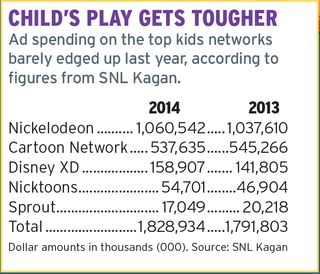With Ratings Down, Kids Nets Stress Multiplatform Ads

Related: Turner’s New Kid On the Kids Block
As the kids upfront approaches, lower ratings are making it harder for marketers to reach young consumers.
For networks, that means more content on more platforms to generate interactivity and engagement to keep money from slipping away to digital and mobile options.
“I think that TV still works,” says Amy Ginsberg, managing director of investment at Initiative. “Will some money move, of course it will.” But TV will still be an important part of the mix. “You have to have a holistic media strategy because that is what truly works.”
Network sales executives are optimistic going into the market, pointing to stronger marketing efforts by toymakers, movie studios and retailers to reach kids and families.
Currently, the big exception to sliding ratings is Turner Broadcasting’s Cartoon Network, which rose last year and is up double digits among kids 2-11 so far this year across a broad array of shows. Last week, Cartoon announced six new programs and 11 returning series.
Donna Speciale, president of ad sales at Turner, says that in addition to its typically strong numbers among boys, Cartoon’s increased viewership includes a lot of girls as well. “We’ll be a much more dual player in the kids’ space,” she says. “We’re probably going to see a larger advertiser base come to us.”
Broadcasting & Cable Newsletter
The smarter way to stay on top of broadcasting and cable industry. Sign up below
With a broader audience, and the return of the Power Puff Girls, Cartoon expects to be a bigger player in licensing with marketers.
At its Feb. 25 upfront, Jim Perry, Nickelodeon head of sales, plans to remind clients that despite lower ratings, Nick remains No. 1. “Looking at the performance of the new SpongeBob movie and Teenage Mutant Ninja Turtles toys, the consumer is still engaged with and consuming our content,” he says.
Perry will be urging clients to keep their ad dollars within the Nickelodeon environment of four linear networks and numerous online and mobile platforms to increase the impact of their marketing. “We’re working much more closely with clients on deeper partnerships that go way beyond TV,” he says.
Over the next two weeks, Disney will be bringing its best clients to either Disney World or Lucasfilm for meetings aimed at finding new opportunities to work together and amplify their marketing messages.
“While linear television will always be the foundation on which we build many of our multiplatform packages, what we found over this last year is that we get an incremental 37% of total impressions when we extend those programs out with [video-on-demand], the Watch App, video on our website or social platforms and games,” says Rita Ferro, executive VP, Disney media sales and marketing.
Ferro says that Disney gives clients an estimate of how many impressions a multiplatform campaign will generate and makes a CPM-like guarantee using the best available research.
Sandy Wax, president of NBCUniversal’s Sprout, says the 10-year-old network will be emphasizing “Fresh First” this season, with a new logo, new on-air look and new original programming coming every quarter.
Originally, Sprout took ads only for moms coviewing with their kids, but now it takes spots aimed at children, says Laura Molen, executive VP for ad sales at NBCU. “We’ve seen growth in the toy category as well as the studio category,”Molen says. Despite figures from SNL Kagan to the contrary Molen maintains ad revenue was up last year.
Molen adds that Sprout is finding new ways to integrate advertisers into network content and is working with other NBCU units. One retailer did a multiplatform campaign built around a contest to find the “kindest kid” in the country. Kids entered via Sprout but voting was promoted on NBC’s Today show.
“By using multiplatform and parts of the NBCU portfolio, clients can expand their message,” Molen says. “Advertisers tell us it works.”
Jon has been business editor of Broadcasting+Cable since 2010. He focuses on revenue-generating activities, including advertising and distribution, as well as executive intrigue and merger and acquisition activity. Just about any story is fair game, if a dollar sign can make its way into the article. Before B+C, Jon covered the industry for TVWeek, Cable World, Electronic Media, Advertising Age and The New York Post. A native New Yorker, Jon is hiding in plain sight in the suburbs of Chicago.

